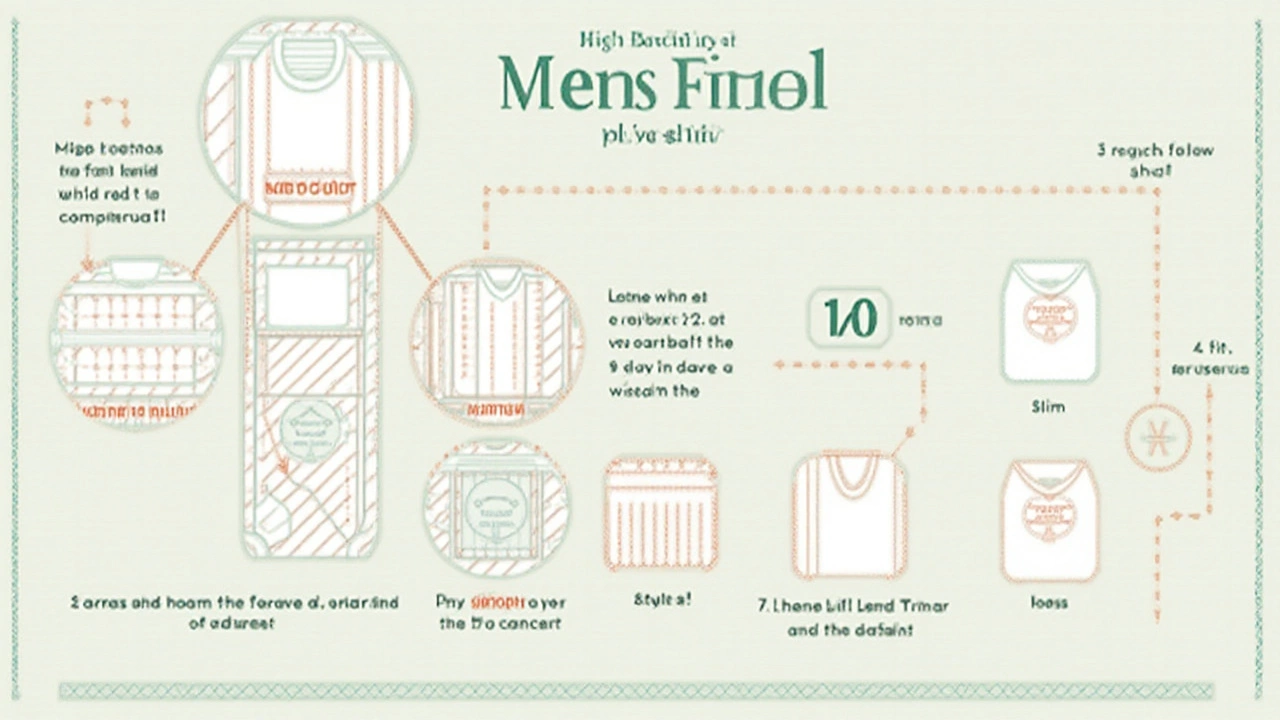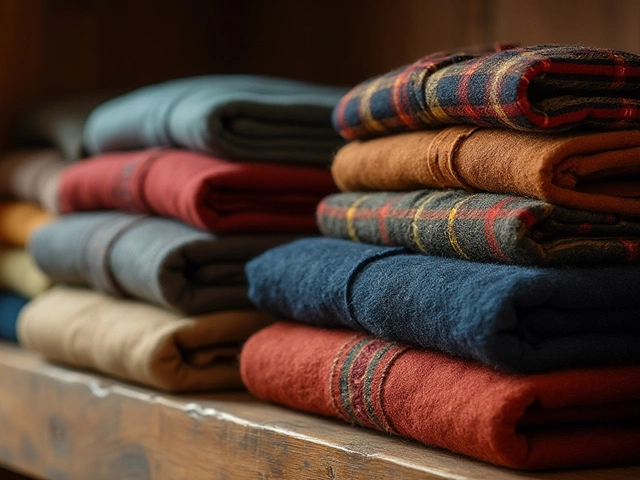In the world of men's fashion, finding the perfect t-shirt is like finding a needle in a haystack. With countless brands and styles to choose from, it can be overwhelming to find the one that fits both your personal style and quality standards. Whether it's for a casual day out or for layering, t-shirts are a staple in every man's wardrobe.
When it comes to quality, there are several factors to keep in mind. Fabric choice, construction, and even the brand's reputation play crucial roles in determining whether a shirt will stand the test of time. A deep dive into the history and values of a brand can often reveal their commitment to producing top-notch garments.
This article will take you on a journey through the essentials of picking the best t-shirts. From understanding the nuances of fabric blends to exploring the benefits of sustainable options, you'll be equipped with the knowledge needed to make confident choices. So, let's unravel the thread that weaves the best men's t-shirts together!
- The Importance of Quality Fabrics
- Top T-Shirt Brands for Men
- Features to Consider
- The Role of Sustainability
- Budget vs. Quality
- Maintenance Tips for Longevity
The Importance of Quality Fabrics
When sorting through the endless racks of men's shirts, the fabric is the first thing you should consider. The type of material used isn't just about look and comfort; it impacts the shirt's durability and how it behaves after several washes. A shirt made of high-quality fabric can withstand more wear and tear, maintaining its shape and color longer than its cheaper counterparts. The fabric also dictates how well a t-shirt will breathe, stretch, and fit your unique body shape, which can ultimately affect your entire day's comfort. A rough or ill-made garment can irritate the skin or feel stifling on a hot day, highlighting the need for selecting the right material.
The two most common materials for t-shirts are cotton and polyester, although blends are becoming increasingly popular. Cotton, renowned for its softness, is an excellent choice for those who value comfort and a natural feel. It's breathable and provides good moisture control, perfect for people with sensitive skin. However, 100% cotton can shrink, so be attentive to manufacturers' care advice. Polyester, on the other hand, is applauded for its flexibility and resistance to wrinkles and shrinking, although it might not give you the airy feel cotton does. The rise of cotton-polyester blends offers the best of both worlds, providing softness and longevity in a single package.
"The difference between a good and a great shirt often lies in its fabric. Prioritize material to ensure long-lasting satisfaction," advises fashion expert Jonathan Park.
There are other materials to keep in mind, too, such as bamboo, modal, and merino wool. Bamboo is heavy on eco-friendly credentials, boasting impressive breathability and antibacterial properties. Modal is a type of rayon and one of the softest materials you'll touch. It lends a silky finish to the garment, draping elegantly. Meanwhile, merino wool, often associated with athletic wear, is celebrated for its moisture-wicking abilities and temperature regulation. Each material offers unique advantages, and that makes understanding fabric composition vital in making an informed decision.
Quality clothing may come at a price, but investing in superior materials pays dividends down the line by extending the garment's life and enhancing your wardrobe's versatility. It's wise to think of your purchase not as a transient trend piece, but rather as a potential staple that could last for years. The decision goes beyond aesthetics, diving deep into practicality and comfort. And with growing awareness of sustainable practices, choosing natural or eco-friendly options contributes positively to the environment. Hence, knowing your fabrics equates to making responsible and enduring wardrobe choices.
Top T-Shirt Brands for Men
When it comes to t-shirts, the choices can feel endless, but certain brands consistently rise to the top due to their commitment to quality and style. These brands understand the nuances of what makes a t-shirt truly great—from the selection of materials to the intricacies of cut and fit.
One such leader in the field is Patagonia, a brand that has built a reputation not just on the durability and comfort of their clothing, but also on a strong commitment to sustainability. They've pioneered the use of recyclable materials in their products and have set a standard for environmentally conscious production. They're an exceptional choice for those wanting to meld fashion with responsibility. An interesting fact is that Patagonia donates a portion of their profits to environmental preservation causes, making every purchase a contribution to the planet.
Then there's Uniqlo, a brand known for its meticulous attention to detail and innovation. With their signature Airism and Supima Cotton tees, they offer a balance of performance and style. Their t-shirts are known for being affordable while maintaining an admirable level of quality. Uniqlo's commitment to fabric innovation means their products stay comfortable and fresh, even after numerous washes. This blend of technology and basic design makes them a favorite for minimalists worldwide.
"Uniqlo is a fantastic choice for those seeking affordable yet high-quality basics," said Colleen Hill, a curator at the Fashion Institute of Technology. "They've mastered the art of creating understated apparel that lasts."
Another noteworthy contender is Tommy John. What makes Tommy John stand out is their focus on fit and comfort. These tees are designed to wash and wear well, flattering a variety of body types without compromising ease of movement. With innovations like their second skin fit, they've effectively solved many common t-shirt woes, such as stretching or fading. When it comes to premium domestic brands, Tommy John continues to gain attention for its relentless drive to improve and provide wearers with comfort without sacrificing style.
For those who prefer something a bit more exclusive, James Perse serves up a luxurious selection. Known for crafting t-shirts that epitomize West Coast casual elegance, James Perse provides a premium experience. The blend of fabrics, which typically includes supremely soft cotton, elevates their tees to another realm of leisurewear. While a bit on the pricier side, the quality ensures these garments are an investment worth making.
Rounding out the selection is a brand that has remained a household name for decades, Ralph Lauren. Famed for their classic polo shirts, Ralph Lauren also delivers when it comes to quality t-shirts for men. With enduring designs and sturdy fabric choices, their wearables often come emblazoned with the iconic polo player logo, a symbol of timeless American style. Ralph Lauren's emphasis on both traditional and modern designs makes it a versatile choice for many.
In the ever-evolving world of fashion, these brands continue to push the envelope, maintaining a delicate balance between innovation and tradition. They provide not only function and comfort but also an expression of personal style. When choosing the perfect t-shirt, paying attention to brand history and values can provide insight into what truly makes a quality shirt worth your investment.
Features to Consider
When it comes to choosing the best men's shirts, especially t-shirts, several key features deserve attention. While it might be tempting to grab the first stylish shirt you see, it's worth diving deeper into the elements that define its quality. Let's start with the fabric - arguably the most critical factor. The feel, longevity, and look of a t-shirt can largely depend on its material. Cotton is a popular choice for many, particularly because of its breathability, softness, and durability. But within cotton, there are varieties, such as Egyptian or Pima, that boast a silkier feel and greater strength.
An often overlooked but vital aspect is the fit of the t-shirt. A well-fitted t-shirt can enhance your appearance while providing comfort. T-shirts are designed with various fits in mind, such as slim, regular, and relaxed. Finding the right fit depends not just on your style preference but also on understanding your body type and the occasion's requirements. For instance, a slim fit might work wonders for a sleek look but may not serve well in more relaxed settings.
Stitching quality is another indicator of a t-shirt's craftsmanship. High-quality shirts will have consistent, even stitching with no loose or broken threads. This kind of attention to detail ensures durability and helps the garment maintain its shape over time. Double-stitched hems and collars can add to the shirt’s strength, reducing wear and tear from regular use.
According to GQ magazine, "Investing in well-made t-shirts doesn't just improve your wardrobe; it supports manufacturers who prioritize ethical production."
Another growing consideration is sustainability. More consumers are leaning towards brands that prioritize eco-friendly practices. Options such as organic cotton or t-shirts made from recycled materials allow you to enjoy fashion without compromising the planet. Plus, these shirts often come from brands whose ethical production processes mean fair wages and humane working conditions for their workers.
The color and pattern options of a t-shirt can also significantly impact your choice. While classic hues like white, black, and navy offer versatility, bolder colors and patterns can add a pop to your wardrobe. The dye quality is crucial here, as it decides whether the shirt will maintain its vibrancy after many washes. Some brands employ artisanal dyeing techniques to ensure a lasting color.
Consider branded logos and prints on t-shirts. A simple, unadorned tee offers a minimalist appeal, while graphic prints can express personality or affiliations. The choice here is entirely subjective, yet, it's wise to choose timeless designs if you want something that remains fashionable across trends.
Lastly, price versus value is always at play. While premium brands often boast higher price tags, they usually justify the cost with quality, design, or ethical production. That said, some affordable brands offer impressive quality. Opting for a known brand often means paying for assured quality and a proven reputation.

The Role of Sustainability
As conversations about climate change and environmental responsibility become ever more pressing, the fashion industry finds itself at a pivotal crossroads. For years, fast fashion has been criticized for its detrimental impact on the environment, prompting many brands to shift their focus towards more sustainable practices. This transformation isn't merely a trend — it's a necessary evolution. For every man looking to upgrade his wardrobe, understanding the role of sustainability in men's shirts is vital. Sustainable fashion is not just about eco-friendly fabrics, it also encompasses ethical labor practices and reduced carbon footprints. When brands embrace this ethos, they contribute to a healthier planet and a more informed consumer base. Such changes are shaping the landscape of fashion toward responsible consumption, a shift that smart consumers are not only embracing but demanding.
Choosing quality clothing that is sustainable often begins with awareness of the fabrics. Organic cotton, for instance, is grown without harmful pesticides, leading to a softer material and less environmental impact. Recycled fibers are also on the rise, giving new life to materials that would otherwise end up in landfills. Some brands go a step further by using innovative fabrics like Tencel, a material made from sustainably harvested wood pulp that’s both breathable and biodegradable. According to an article in Vogue, "consumers are not just buying products, they are buying into a promise of change" as reported in their June 2023 issue. This shift, they claim, aligns with a growing understanding that fashion has a direct impact on our planet's health.
The Impact on Brand Reputation
Embracing sustainability can also influence a brand’s reputation significantly. Consumers today seek transparency; they want to know where their t-shirts are made, by whom, and under what conditions. Brands that openly share their supply chain and production methods can build trust with their audience. This commitment to ethical practices doesn’t only win the hearts of conscious consumers, it often translates into brand loyalty and positive word-of-mouth marketing. Companies like Patagonia have built business models around environmental stewardship, showing that sustainability can be a successful business strategy. Therefore, the role of sustainability isn't just about the environment; it affects business and consumer behavior in profound ways.Let's explore some numbers to get a clearer picture. According to the Global Fashion Agenda, shifting to a circular fashion system could unlock $192 billion worth of value in the environment and society by 2030. Adopting circular practices, like recycling and reusing materials, helps create a closed-loop system, reducing waste and resource consumption. For those searching for the best t-shirts, supporting brands that commit to these sustainable practices means backing a future where fashion and nature go hand in hand. The choice of fashion is now more than a personal style statement; it's a beacon for change.
Ultimately, opting for sustainable men's shirts is about making informed choices. Beyond the individual gains, it contributes to a larger narrative that emphasizes preservation and responsibility. Whether it's selecting a t-shirt crafted ethically or exploring brands pioneering sustainability, every decision makes a difference. As more men recognize the power they wield with every purchase, the path toward a sustainable wardrobe becomes not just a possibility, but a necessity. This is the future of fashion — where style meets sustainability in harmony.
Budget vs. Quality
When it comes to shopping for men's shirts, the age-old debate between budget and quality always emerges. On one hand, everyone's wallet has a limit, urging for frugality. On the other, the allure of high-quality t-shirts that promise durability and comfort often tugs in the opposite direction. The key is finding that sweet spot where cost and quality meet in harmony. Many brands offer affordable options that don't compromise entirely on quality, while premium brands justify their hefty price tags with advanced fabric technology and impeccable craftsmanship.
The choice between budget and quality can deeply influence wardrobe longevity. Budget-friendly shirts might allow you to expand your style by having more options, yet these often come at the expense of durability. A cheap t-shirt might look great initially but could fade or lose its shape after just a few washes. Conversely, a high-quality t-shirt, though more expensive, often proves to be a wise investment. Many times, you may find that a premium shirt holds up well over numerous washes, retaining its form and feel. According to a study in 'Textile Journal', investing in quality apparel can reduce annual clothing expenses by up to 40%, as fewer replacements are needed.
"Quality is remembered long after the price is forgotten," famously quoted by Aldo Gucci, drives home the idea of prioritizing quality even when weighing options against cost.
The role of sustainable practices in the fashion industry cannot be overlooked. Often, brands that focus on high quality are also those that emphasize on sustainable and ethical practices. Sure, these shirts may carry a higher price point, but they often come with the peace of mind that you are not endorsing exploitative labor practices or environmental degradation. Brands like Patagonia and Everlane have set benchmarks in producing ethical and high-quality clothing, proving that it is possible to marry great craftsmanship with positive impact. They even transparently share their production processes and sourcing material—information that cheap alternatives tend to obscure.
Striking the right decision involves an assessment of personal priorities. For those constantly seeking new trends, budget shirts can provide variety without hurting the wallet. However, if classic staples and durability are more up your alley, investing in higher-quality fashion pieces makes more sense. A potential strategy is to mix and match—investing in high-quality basics that you wear frequently, while opting for budget-friendly trendy pieces that may not need to last a lifetime. Consider your lifestyle, habits, and wardrobe needs when making these decisions. Doing so ensures a balance where your clothes reflect your style, align with your values, and still respect your finances.
Ultimately, whether you choose to embrace budget options or high-quality alternatives, being equipped with the right knowledge makes all the difference. Understanding the long-term implications, both environmentally and economically, can guide you to make decisions that you'll be happy with in the long run. It's not just about the cost of the shirt itself but the value it adds to your life.
Maintenance Tips for Longevity
Preserving the lifespan of your favorite men's shirts doesn't have to be a daunting task if you know exactly what steps to follow. First and foremost, always check the care label inside your t-shirts. Following these guidelines is akin to having a direct line to the creators of the shirt. Once you know whether your shirt prefers a cold or warm bath in the washing machine, you'll be halfway through ensuring its longevity. Remember, hot water is often the culprit in shrinking and fading, which can turn that beloved black shirt into a worn-out gray relic.
Additionally, you might want to consider turning your t-shirts inside out before washing. This simple trick helps protect the fabric and keeps the colors vibrant for longer. Another step in safeguarding the future of your shirts is to avoid overcrowding the washing machine. T-shirts rubbing against each other continuously can cause friction, leading to pilling. This is where the shirt's surface develops those annoying little balls or fuzz. To minimize this, wash lighter clothes like t-shirts in smaller loads.
Drying Techniques
The drying process is where many go astray, resulting in irreversible damage to their quality clothing. First, it is advisable to air-dry your shirts whenever possible. Hanging them on a clothesline in the sun not only saves energy but also prevents the fibers from breaking down due to aggressive tumble drying. Remember to shape them carefully to avoid awkward creases that could set as they dry. If you must use a dryer, set it on a low or delicate heat to minimize the risk of shrinkage.
"A carefully cared-for t-shirt can last you not just seasons, but years," says Jane Anderson, a textile conservation expert. "It's about knowing the do's and don'ts of fabric care."
If hanging isn't an option, consider laying them flat on a clean, dry towel. This gentle way of drying supports the weight of the fabric evenly, preventing stretching. Make sure you avoid wringing out your shirts to remove excess water, as this can distort their shape. Gently patting them dry with a towel is a much more effective strategy.
Storage Solutions
Once your shirts are clean and dry, storage is the next crucial step. It might sound trivial, but how you store your t-shirts plays a significant role in maintaining their form and extending their lifespan. Folding them neatly in a drawer can keep them in better condition than hanging. The hangers can eventually stretch the fabric, especially around the shoulders, which can lead to an unsightly, exaggerated silhouette. If space allows, rolling your shirts can also prevent unwanted creases and save room for more additions to your collection.
Placement matters too; try storing your shirts in a cool, dry place. Too much humidity can not only make them smell musty but also encourages mildew growth, which can be both damaging and difficult to remove. A well-ventilated wardrobe is your best bet here, and tossing in some moisture absorbers could do wonders. If your shirts have spent a long time nestled at the bottom of a drawer, it's a good idea to freshen them up before wearing. Giving them a little shake or steaming them back into prime shape is a quick fix to those storage wrinkles.





